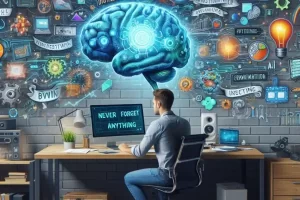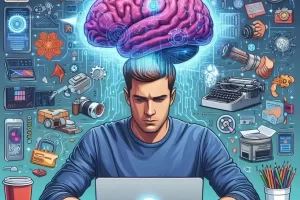One of the most overlooked powers of a second brain is its ability to help you build long-term, cumulative knowledge. Instead of learning, forgetting, and repeating the cycle, your second brain — when enhanced with artificial intelligence (AI) — becomes a living archive that remembers everything and grows smarter over time.
In this article, you’ll learn how to use your second brain to go beyond storing notes. You’ll discover how to structure your thinking, retain what matters, and evolve your expertise with the help of AI.
Why Long-Term Knowledge Beats Short-Term Memory
In today’s fast-paced world, it’s easy to consume endless information — but hard to retain and apply it.
Without a system:
- You forget key lessons from books and courses
- You revisit the same topics over and over
- You struggle to connect ideas across time
Your brain wasn’t designed to store everything — but your second brain was. And when powered by AI, it becomes your long-term thinking partner.
Start with the “Knowledge Collector” Mindset
Every day, you come across things worth remembering:
- A quote in a book
- A tip from a podcast
- A process you developed
- A mistake you don’t want to repeat
- An insight during a conversation
Instead of letting these disappear, capture them immediately.
Use:
- Readwise to save highlights
- Notion Web Clipper for articles
- Voice notes + Otter.ai for quick reflections
- ChatGPT to summarize and store ideas from conversations or writing sessions
Let AI help you turn messy inputs into clean, usable knowledge entries.
Structure Knowledge by Concepts, Not Just Topics
Instead of organizing your notes like a textbook (chapter 1, chapter 2), use a conceptual approach:
- Group by mental models
- Build pages for “principles” instead of just subjects
- Create hubs like “What I Know About Productivity” or “Insights on Human Behavior”
Ask AI to help:
“Based on these notes, what themes or concepts are emerging?”
“Which of these ideas relate to focus and motivation?”
This creates flexible knowledge blocks that grow over time.
Build Evergreen Notes
Evergreen notes are permanent, evolving pieces of knowledge — not just raw ideas. These are the core insights you want to revisit and refine forever.
To build them:
- Start with an idea
- Summarize it in your own words
- Link it to related notes
- Update it when your thinking evolves
Use AI to:
- Turn raw notes into evergreen notes
- Suggest improvements or examples
- Link one evergreen note to others in your system
Prompt:
“Turn these bullet points into a permanent, structured note about time management.”
“What other evergreen notes should this one connect to?”
Review and Evolve Your Thinking
The power of long-term knowledge comes from revisiting and updating what you know.
Let AI assist in your review process:
- “Which evergreen notes haven’t been updated in 90 days?”
- “What have I learned recently that could expand this idea?”
- “Summarize how my understanding of creativity has changed over the past year.”
AI can even track your intellectual growth and help refine your frameworks.
Connect Ideas Across Time
You’ve probably had brilliant ideas in the past — but forgotten them. AI helps resurface and connect them to new ones.
Ask:
- “What past notes relate to this new article I saved?”
- “Show me all entries I’ve made about focus in the last year.”
- “What are the common patterns in my notes about writing?”
This is where your second brain starts to feel like a thinking assistant — not just a digital drawer.
Turn Knowledge into Output
Knowledge compounds best when used. AI helps you turn what you’ve stored into:
- Blog posts
- Content ideas
- Courses or frameworks
- Personal insights or reflection essays
Prompts:
- “Turn these notes into a blog outline.”
- “What are 5 takeaways from this evergreen note that I can share publicly?”
- “Create a visual summary of this concept for a presentation.”
This moves your second brain from input storage to output generation.
Create a Knowledge Graph
Tools like Obsidian or Tana allow you to visualize how your ideas are connected. AI can help you:
- Auto-link notes
- Suggest new relationships
- Generate concept maps
This visual layer helps you see:
- Gaps in your knowledge
- Overlapping ideas
- The structure of your understanding
Ask:
“Generate a map of all notes related to learning and teaching.”
“What themes connect my top 20 most-viewed notes?”
Teach Your AI About Your Thinking
With tools like ChatGPT’s custom GPTs or memory-enabled assistants, you can train AI on:
- Your way of writing
- Your frameworks
- Your recurring themes
Now, when you ask for help, AI can answer in your voice, using your ideas.
For example:
- “Help me refine my note on digital minimalism.”
- “Summarize my views on motivation from across my notes.”
- “What’s my current thinking on remote work?”
Over time, your second brain doesn’t just store — it thinks with you.
Real-Life Example: The Thought Leader Workflow
Let’s say you’re a consultant building thought leadership content. Your second brain helps you:
- Save ideas from client calls and reading
- Summarize them into evergreen principles
- Link them to your own models and research
- Let AI generate new insights and content ideas
- Turn that content into newsletters, articles, or presentations
Instead of reinventing the wheel, you build on your own intellectual capital — stored, searchable, and always expanding.
Final Thoughts: Build for Growth, Not Just Storage
Long-term knowledge isn’t built from memory — it’s built from systems. Your second brain, enhanced by AI, becomes the place where your insights accumulate, connect, and evolve.
Start today by capturing valuable ideas, structuring them as concepts, and using AI to help you think deeper and smarter over time. With consistency, you’ll create a second brain that becomes a source of confidence, clarity, and creativity — now and for years to come.




